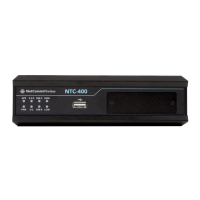6.3 Authentication
Use either the Captive Portal or MAC Authentication tools to set up a WiFi Hotspot using the NTC-400 Series Router router.
6.3.1 Captive Portal
A captive portal, also known as a gateway, is a portal web page that is displayed before a user can browse Internet through
your router. The portal is often used to present a login web page which can include an authentication process and/or
payment, or simply display an acceptable use policy and require the user to agree. Captive portals are used to provide Wi-Fi
hotspot services or can be used to control wired access, for example: apartment buildings, hotel rooms, business premises,
"open" Ethernet jacks, etc.
The gateway supporting the Captive Portal function can be implemented via two approaches: External Web Portal or
Internal Web Portal
For an external captive portal, you must specify an external RADIUS (Remote Authentication Dial In User Service) server and
an external UAM (Universal Access Method) server. In contrast, the internal captive portal uses the “Internal RADIUS Server”
option for user authentication. The user account database can be an embedded database, an external AD database or an
external LDAP database. However, the UAM server is not necessary for this case and that the captive portal Web site is
embedded in the device.
External Captive Portal
For external captive portal, you must specify an external RADIUS (Remote Authentication Dial In User Service) server and
external UAM (Universal Access Method) server.
Before enabling the external Captive Portal function, Go to [Object Definition]-[External Server] to setup external server
objects, like RADIUS server and UAM server. Return to this page to configure the Captive Portal function for the specific WAN
Interface. Select external Authentication Server and UAM Server from the pre-defined external server object list.

